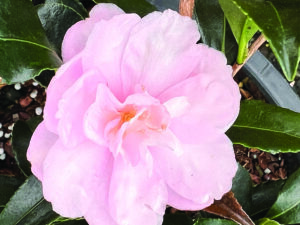
Among the varieties of fall blooming Camellias are the “Autumn Sentinel.” (Photo by Ginny Rosenkranz)
The fall blooming Camellia, also known as Camellia sasanqua, brings both beautiful glossy evergreen leaves to the gardens but it also brings beautiful flowers in shades of bright red, pinks and whites.
These cold-tolerant, lightly fragrant flowers bloom from September to December, open their petals to 2-3 inches in diameters that surround bright yellow male stamens. When the flowers begin to fade, their petals float down to carpet the ground, mirroring the colors still on the plants.
Flowers can grow with single row of petals surrounding the central stamens or semi double and there are some that are double-flowered forms.
When in bloom the flowers attract the late fall pollinators, providing nectar when most flowers have stopped blooming.
Although the flowers last only a few days, the plants continue to bloom for four to six weeks.
The dark-green shiny, leathery leaves are smaller than the spring blooming camellias, growing on 2-3 inches long, oval shaped with small notches along the outline and are attached to the stems in an alternate fashion.
Plants can grow six to 14 feet tall and 5-7 feet wide, thriving in morning sun and afternoon shade, and protection from the cold north and west winds.
These lovely blooming shrubs prefer moist, well drained soils and is also slightly salt tolerant, making it a wonderful addition to most landscapes.
(Editor’s Note: Ginny Rosenkranz is a commercial horticulture specialist with the University of Maryland Extension.)



